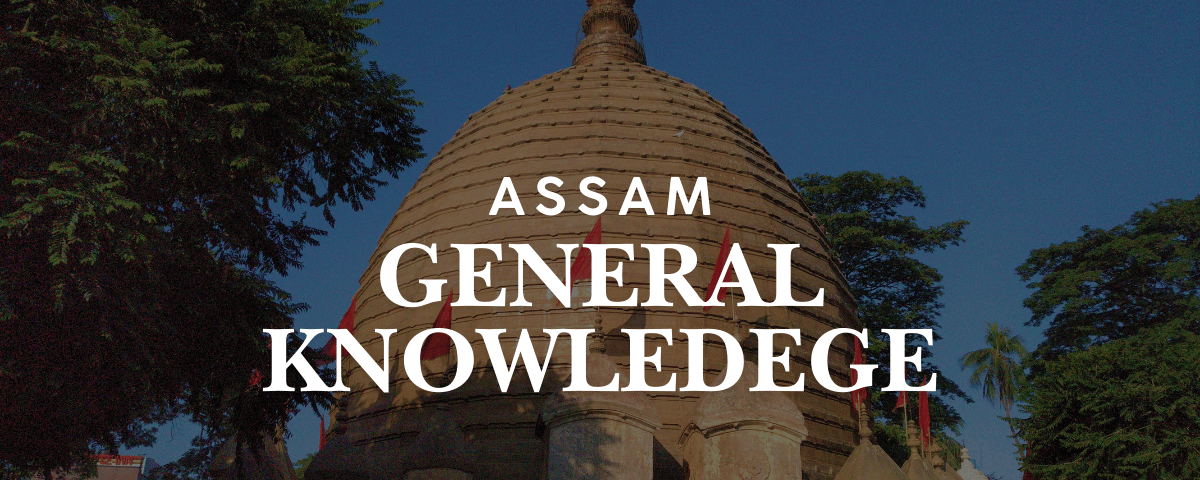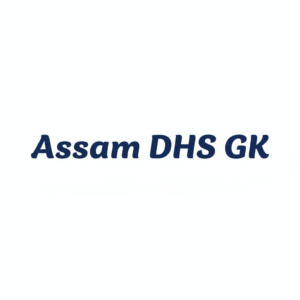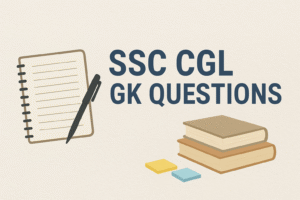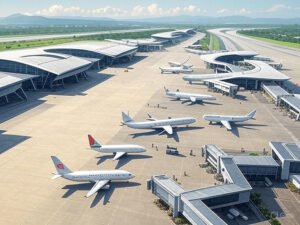Assam History MCQ
Explore Assam’s rich historical tapestry with this Assam History MCQ collection, featuring 100 unique questions tailored for competitive exams like APSC, UPSC, and state-level tests. Covering ancient kingdoms, Ahom administration, cultural milestones, colonial resistance, and modern developments, these Assam History MCQs are your ultimate resource for mastering Assam’s past. Perfect for students and aspirants, this compilation ensures comprehensive preparation with verified, accurate answers.
Ancient and Early Medieval History : Assam History
- Which ancient kingdom in Assam was known for its trade with Southeast Asia?
A) Kamarupa
B) Chutia
C) Koch
D) Ahom
Answer: A) Kamarupa - Who was the first Varman king to perform the Ashvamedha sacrifice?
A) Pushyavarman
B) Bhaskarvarman
C) Samudravarman
D) Naraka
Answer: B) Bhaskarvarman - The Bhauma-Naraka dynasty is associated with which legendary founder in Assam History ?
A) Narakasura
B) Bhagadatta
C) Banamala
D) Harshavardhana
Answer: A) Narakasura - Which Chinese traveler visited Kamarupa during Bhaskarvarman’s reign?
A) Fa-Hien
B) Xuanzang
C) I-Tsing
D) Marco Polo
Answer: B) Xuanzang - The Hayagriva Madhava Temple in Hajo was originally associated with which religion?
A) Vaishnavism
B) Buddhism
C) Shaktism
D) Jainism
Answer: B) Buddhism - The “Silimpur Inscription” belongs to the reign of which dynasty?
A) Salastambha
B) Pala
C) Varman
D) Ahom
Answer: B) Pala
Ahom Dynasty – Administration and Society : Assam History
- Which Ahom king introduced the position of Barpatra Gohain to strengthen administration?
A) Suhungmung
B) Susenpha
C) Suklenmung
D) Sutingpha
Answer: A) Suhungmung - The Ahom title “Chao-Pha” refers to:
A) Chief priest
B) King
C) Military general
D) Revenue officer
Answer: B) King - Which Ahom king established the office of Bar Barua to oversee civil administration?
A) Pratap Singha
B) Suhungmung
C) Suklenmung
D) Gadadhar Singha
Answer: B) Suhungmung - The Ahom system of land measurement was known as:
A) Bigha
B) Pura
C) Kani
D) Lessa
Answer: B) Pura - Which Ahom king is credited with promoting intermarriage between Ahoms and other communities?
A) Rudra Singha
B) Siva Singha
C) Suklenmung
D) Susenpha
Answer: A) Rudra Singha - The “Bara Gohain” and “Burha Gohain” were:
A) Military commanders
B) Tribal chiefs
C) Ministers in Ahom administration
D) Religious priests
Answer: C) Ministers in Ahom administration - The “Phuleshwari Konwari” was the chief queen during which king’s reign?
A) Rudra Singha
B) Siva Singha
C) Gadadhar Singha
D) Rajeswar Singha
Answer: B) Siva Singha - Who was called “Bhagania Raja” because he fled his capital during Mir Jumla’s invasion?
A) Jayadhwaj Singha
B) Rudra Singha
C) Chakradhwaj Singha
D) Sulikpha
Answer: A) Jayadhwaj Singha - Who officiated as the Barphukan during Mir Jumla’s invasion?
A) Baduli Phukan
B) Atan Burhagohain
C) Momai Tamuli Barbarua
D) Laluksola Barphukan
Answer: A) Baduli Phukan - Who was the puppet king installed by the Burmese during their occupation of Assam?
A) Purandar Singha
B) Chandrakanta Singha
C) Jogeswar Singh
D) Ruchinath Burhagohain
Answer: C) Jogeswar Singh - The capital city “Garhgaon” belonged to which dynasty?
A) Pala
B) Ahom
C) Varman
D) Koch
Answer: B) Ahom
Ahom Dynasty – Conflicts and Diplomacy : Assam History
- Which Ahom king faced the first Mughal invasion led by Khwaja Usman in 1615?
A) Pratap Singha
B) Susenpha
C) Suhungmung
D) Suklenmung
Answer: A) Pratap Singha - The Battle of Samdhara in 1616 was fought between the Ahoms and:
A) Mughals
B) Koch
C) Chutia
D) Kachari
Answer: A) Mughals - Which treaty ended the Ahom-Kachari conflict in 1563?
A) Treaty of Majuli
B) Treaty of Ghilajharighat
C) Treaty of Asurar Ali
D) Treaty of Sootea
Answer: D) Treaty of Sootea - Who was the Ahom general who led the defense against the Mughal invasion of 1669?
A) Lachit Borphukan
B) Atan Burhagohain
C) Dihingia Alun Barbarua
D) Langi Panihia
Answer: B) Atan Burhagohain - Which Ahom king negotiated peace with the Mughals after the Battle of Alaboi?
A) Chakradhwaj Singha
B) Udayaditya Singha
C) Jayadhwaj Singha
D) Gadadhar Singha
Answer: A) Chakradhwaj Singha - The battle fought at the confluence of the Kalang and Brahmaputra rivers in 1532 was against whom in the history of Assam ?
A) Mughals
B) Koch dynasty
C) Muslim general Turbak Khan
D) Burmese
Answer: C) Muslim general Turbak Khan - The Battle of Alaboi resulted in heavy loss for which side?
A) Mughals
B) Ahoms
C) Burmese
D) British
Answer: B) Ahoms
Koch and Chutia Dynasties : Assam History
- Who was the founder of the Koch dynasty in this Assam History ?
A) Biswa Singha
B) Naranarayan
C) Chilarai
D) Prithu
Answer: A) Biswa Singha - Which Koch king expanded the kingdom to include parts of Bengal and Bhutan?
A) Naranarayan
B) Chilarai
C) Biswa Singha
D) Lakshminarayan
Answer: B) Chilarai - The Chutia kingdom was annexed by the Ahoms under which king?
A) Suhungmung
B) Suklenmung
C) Pratap Singha
D) Rudra Singha
Answer: A) Suhungmung - Which Chutia king is associated with the construction of Tamreswari Temple?
A) Ratnadhwajpal
B) Dhirnarayan
C) Nitipal
D) Satyanarayan
Answer: A) Ratnadhwajpal - The Koch capital Cooch Behar was established by:
A) Biswa Singha
B) Naranarayan
C) Chilarai
D) Lakshminarayan
Answer: A) Biswa Singha
Cultural and Religious Contributions : Assam History
- Which Assamese saint composed the “Kirtan Ghosa” to spread Neo-Vaishnavism?
A) Madhabdev
B) Srimanta Sankardev
C) Damodardev
D) Haridev
Answer: B) Srimanta Sankardev - The “Borgeet” is a form of devotional music composed by whom?
A) Srimanta Sankardev
B) Madhabdev
C) Both A and B
D) Ananta Kandali
Answer: C) Both A and B - Which institution established by Srimanta Sankardev served as a center for religious and cultural activities?
A) Namghar
B) Sattra
C) Xatra
D) Mandir
Answer: B) Sattra - The “Ankiya Nat” is a form of:
A) Folk dance
B) One-act play
C) Devotional song
D) Martial art
Answer: B) One-act play - Which Ahom king patronized the construction of the Vishnu Dol temple in Sivasagar?
A) Siva Singha
B) Rudra Singha
C) Pramatta Singha
D) Rajeswar Singha
Answer: A) Siva Singha - Who wrote the book “Hastividyarnava” related to elephants?
A) Kabiraj Chakraborty
B) Sukumar Borkaith
C) Dilbar
D) Dwijendra Lal Baruah
Answer: B) Sukumar Borkaith - The “Axomiya Bhasa Unnati Sadhini Sabha” was founded to promote:
A) English education
B) Assamese language and culture
C) Trade and commerce
D) Political reforms
Answer: B) Assamese language and culture - The famous “Assamiya Sahitar Buranji,” the first Assamese history book on literature, was published in:
A) 1905
B) 1912
C) 1920
D) 1930
Answer: B) 1912 - The famous Assamese dramatist who composed “Kumar Haran” is:
A) Aniruddha
B) Lakshminath Bezbarua
C) Homen Borgohain
D) Sridhara Kandali
Answer: D) Sridhara Kandali
Architecture and Monuments : Assam History
- The Gaurisagar Tank was constructed under whose patronage?
A) Rudra Singha
B) Phuleshwari
C) Siva Singha
D) Ambika
Answer: B) Phuleshwari - Which Ahom king built the Charaideo Maidam as a royal burial site?
A) Sukaphaa
B) Suhungmung
C) Rudra Singha
D) Siva Singha
Answer: A) Sukaphaa - The Kareng Ghar, also known as the Garhgaon Palace, was constructed by:
A) Suklenmung
B) Pratap Singha
C) Rajeswar Singha
D) Gadadhar Singha
Answer: A) Suklenmung - Which monument in Assam is known as the “Bamboo Bridge of Nongriat”?
A) Living Root Bridge
B) Namdang Stone Bridge
C) Dhola-Sadiya Bridge
D) Kalia Bhomora Bridge
Answer: A) Living Root Bridge - The Rudrasagar Tank in Sivasagar was built during the reign of:
A) Rudra Singha
B) Lakshmi Singha
C) Siva Singha
D) Rajeswar Singha
Answer: C) Siva Singha - The “Sibsagar Tank” was excavated by whom?
A) Phuleshwari
B) Draupadi
C) Ambika
D) All the above queens of Siva Singha
Answer: D) All the above queens of Siva Singha - The “Kharikatia Ali” was built during the reign of:
A) Rudra Singha
B) Gadadhar Singha
C) Sulikpha
D) Pratap Singha
Answer: A) Rudra Singha
Colonial Period and Resistance : Assam History
- The first major peasant revolt against the British in Assam was:
A) Phulaguri Dhawa
B) Lachima Uprising
C) Patharughat Movement
D) Rangia Uprising
Answer: A) Phulaguri Dhawa - The first British Commissioner of Assam after the Treaty of Yandaboo was:
A) David Scott
B) Thomas Anstey
C) Francis Jenkins
D) John Butler
Answer: A) David Scott - Which Assamese leader was exiled to the Andaman Islands for his role in the 1857 revolt?
A) Maniram Dewan
B) Piyoli Barua
C) Anandaram Dhekial Phukan
D) Hemchandra Barua
Answer: A) Maniram Dewan - The Assam Land and Revenue Regulation was introduced in which year?
A) 1828
B) 1833
C) 1845
D) 1861
Answer: B) 1833 - Who was the first Assamese to pass the Indian Civil Service examination?
A) Anandaram Dhekial Phukan
B) Hemchandra Barua
C) Lakshminath Bezbarua
D) Anundoram Borooah
Answer: D) Anundoram Borooah - Who was the famous Assamese freedom fighter shot dead during the Quit India Movement in Gohpur?
A) Lalit Kumar Doley
B) Kanaklata Barua
C) Ambikagiri Raychoudhury
D) Tarun Ram Phukan
Answer: B) Kanaklata Barua - The peaceful political protest against the partition of Bengal in Assam was led by:
A) Ambikagiri Raychoudhury
B) Manik Chandra Baruah
C) Kanaklata Barua
D) Jagannath Baruah
Answer: D) Jagannath Baruah
Modern History and Institutions : Assam History
- Which Assamese journal, started in 1889, promoted literary and cultural revival?
A) Jonaki
B) Bahni
C) Usha
D) Ramdhenu
Answer: A) Jonaki - The Assam Agricultural University was established in which year?
A) 1969
B) 1972
C) 1960
D) 1980
Answer: A) 1969 - Who was the first Assamese woman to become a member of the Assam Legislative Assembly?
A) Kanaklata Barua
B) Anwara Taimur
C) Pushpalata Das
D) Renuka Devi Barkataki
Answer: C) Pushpalata Das - The Guwahati High Court was established in which year?
A) 1947
B) 1948
C) 1950
D) 1960
Answer: B) 1948 - Which Assamese leader served as India’s fifth President?
A) Gopinath Bordoloi
B) Fakhruddin Ali Ahmed
C) Bimala Prasad Chaliha
D) Tarun Gogoi
Answer: B) Fakhruddin Ali Ahmed - Who was the first president of the Assam Association formed in 1903?
A) Manik Chandra Baruah
B) Raja Prabhat Chandra Baruah
C) Jagannath Baruah
D) Gopinath Bordoloi
Answer: B) Raja Prabhat Chandra Baruah - Which Assamese poet was awarded the Jnanpith Award?
A) Lakshminath Bezbarua
B) Indira Goswami
C) Homen Borgohain
D) Bishnu Rabha
Answer: B) Indira Goswami - The first oil refinery in Asia was established at:
A) Digboi
B) Sivasagar
C) Guwahati
D) Dibrugarh
Answer: A) Digboi - The first tea research center in Assam was established at:
A) Dibrugarh
B) Jorhat
C) Guwahati
D) Sivasagar
Answer: B) Jorhat - The historic Northbrook Gate was built in which year?
A) 1865
B) 1874
C) 1880
D) 1890
Answer: B) 1874 - The Tea Auction Centre in Guwahati was established in which year?
A) 1965
B) 1970
C) 1975
D) 1980
Answer: B) 1970 - The Kalia Bhomora Bridge is constructed over which river?
A) Brahmaputra
B) Manas
C) Dhansiri
D) Subansiri
Answer: A) Brahmaputra - The union government declared “Majuli” as:
A) National Park
B) Heritage Site
C) Eco-sensitive Zone
D) Wildlife Sanctuary
Answer: C) Eco-sensitive Zone - The Assam Valley Literary Award was given to which of the following personalities?
A) Lakshminath Bezbarua
B) Bhupen Hazarika
C) Homen Borgohain
D) Both B and C
Answer: D) Both B and C - The first railway line in Assam was opened between which two places?
A) Guwahati and Jorhat
B) Dibrugarh and Margherita
C) Guwahati and Tezpur
D) Jorhat and Sibsagar
Answer: B) Dibrugarh and Margherita - The Assam Accord, addressing illegal immigration, was signed in which year?
A) 1979
B) 1983
C) 1985
D) 1990
Answer: C) 1985 - Who was the first Chief Minister of Assam to serve three consecutive terms?
A) Gopinath Bordoloi
B) Tarun Gogoi
C) Bimala Prasad Chaliha
D) Sarbananda Sonowal
Answer: B) Tarun Gogoi - The Kaziranga National Park was declared a UNESCO World Heritage Site in:
A) 1980
B) 1985
C) 1990
D) 1995
Answer: B) 1985 - Which Assamese film director won the National Film Award for “Halodhia Choraye Baodhan Khai”?
A) Jahnu Barua
B) Bhabendra Nath Saikia
C) Bhupen Hazarika
D) Zubeen Garg
Answer: A) Jahnu Barua - The Assam Science and Technology University was established in:
A) 2000
B) 2005
C) 2010
D) 2011
Answer: D) 2011
Cultural Festivals and Traditions : Assam History
- The “Ali-Aye-Ligang” festival is celebrated by which community in Assam?
A) Bodo
B) Mising
C) Karbi
D) Dimasa
Answer: B) Mising - Which festival involves the worship of the Kachari deity Bathou?
A) Bihu
B) Baishagu
C) Jonbeel Mela
D) Ambubachi Mela
Answer: B) Baishagu - The Jonbeel Mela is primarily associated with which community?
A) Tiwa
B) Rabha
C) Mising
D) Deori
Answer: A) Tiwa - Which traditional Assamese dance is performed during the Bohag Bihu festival?
A) Satriya
B) Bihu dance
C) Bagurumba
D) Ojapali
Answer: B) Bihu dance - The Ambubachi Mela is held annually at which temple?
A) Kamakhya Temple
B) Umananda Temple
C) Sivadol Temple
D) Hayagriva Madhava Temple
Answer: A) Kamakhya Temple - The Assam Movement of 1979 was primarily against:
A) British colonial rule
B) Illegal immigration
C) Mughal invasions
D) Burmese invasions
Answer: B) Illegal immigration - Which Assamese tribe is known for the “Bohagiyo Bishu” festival?
A) Deori
B) Mising
C) Karbi
D) Dimasa
Answer: A) Deori - The Assam Legislative Assembly was first established in which year?
A) 1937
B) 1947
C) 1952
D) 1960
Answer: A) 1937
Literature and Language : Assam History
- Who wrote the Assamese epic poem “Ramayana” translated into Assamese verse?
A) Madhab Kandali
B) Srimanta Sankardev
C) Hemchandra Barua
D) Lakshminath Bezbarua
Answer: A) Madhab Kandali - The “Orunodoi” magazine, the first Assamese periodical, was first published in:
A) 1846
B) 1856
C) 1866
D) 1876
Answer: A) 1846 - Who is known as the “Sahitya Kandari” for his contributions to Assamese literature?
A) Lakshminath Bezbarua
B) Hemchandra Barua
C) Anandaram Dhekial Phukan
D) Hiren Bhattacharyya
Answer: C) Anandaram Dhekial Phukan - The Assamese novel “Mamare Dhara Tarowal” was written by:
A) Indira Goswami
B) Lakshminath Bezbarua
C) Homen Borgohain
D) Bhabendra Nath Saikia
Answer: A) Indira Goswami - Which script was standardized for the Assamese language in the 19th century?
A) Devanagari
B) Bengali-Assamese
C) Tai Ahom
D) Roman
Answer: B) Bengali-Assamese - Who was the author of the earliest Ahom Buranji ?
A) S.K. Bhuyan
B) Rudra Singha
C) Sukumar Barkaith
D) Bangkok Buranji chroniclers
Answer: A) S.K. Bhuyan (modern historian who compiled and translated)
Economic and Industrial Developments : Assam History
- The first tea garden in Assam was established at:
A) Chabua
B) Jorhat
C) Dibrugarh
D) Tinsukia
Answer: A) Chabua - Which British official is credited with discovering tea in Assam in 1823?
A) Robert Bruce
B) David Scott
C) Charles Alexander Bruce
D) Francis Jenkins
Answer: A) Robert Bruce - The Assam Oil Company was founded in which year?
A) 1889
B) 1899
C) 1909
D) 1919
Answer: A) 1889 - The first modern cotton mill in Assam was established at:
A) Guwahati
B) Dibrugarh
C) Tezpur
D) Nagaon
Answer: B) Dibrugarh - The Dhola-Sadiya Bridge, the longest bridge in India, was inaugurated in:
A) 2015
B) 2017
C) 2019
D) 2021
Answer: B) 2017
Freedom Movement and Leaders : Assam History
- Who founded the Assam branch of the Indian National Congress in 1921?
A) Tarun Ram Phukan
B) Nabin Chandra Bordoloi
C) Ambikagiri Raychoudhury
D) Kuladhar Chaliha
Answer: A) Tarun Ram Phukan - Which Assamese freedom fighter was known as the “Lion of Assam”?
A) Kushal Konwar
B) Tarun Ram Phukan
C) Bishnu Ram Medhi
D) Ambikagiri Raychoudhury
Answer: D) Ambikagiri Raychoudhury - The Assam Students’ Conference, a precursor to the Assam Movement, was first held in:
A) 1916
B) 1920
C) 1926
D) 1930
Answer: A) 1916 - Who was the first Assamese woman martyr in the freedom struggle?
A) Kanaklata Barua
B) Pushpalata Das
C) Anwara Taimur
D) Chandraprabha Saikiani
Answer: A) Kanaklata Barua - Which Assamese leader was a key figure in the Non-Cooperation Movement in Assam?
A) Nabin Chandra Bordoloi
B) Tarun Ram Phukan
C) Gopinath Bordoloi
D) Bishnu Ram Medhi
Answer: B) Tarun Ram Phukan
Miscellaneous : Assam History
- Which river is known as the “Lifeline of Assam”?
A) Barak
B) Brahmaputra
C) Subansiri
D) Dhansiri
Answer: B) Brahmaputra - The traditional Assamese weaving technique “Muga” is associated with which silk?
A) Eri
B) Muga
C) Pat
D) Tussar
Answer: B) Muga - The Barak Valley is mainly inhabited by which community?
A) Assamese
B) Bengali speakers
C) Bodos
D) Karbis
Answer: B) Bengali speakers - Which Assamese tribe is known for the “Bohagiyo Bishu” festival?
A) Deori
B) Mising
C) Karbi
D) Dimasa
Answer: A) Deori
Elevate your exam preparation with these 100 Assam History MCQs, meticulously crafted for APSC, UPSC, and state-level competitive exams. Covering ancient kingdoms, Ahom legacy, cultural heritage, and modern milestones, this Assam History MCQ collection is your key to mastering Assam’s history. practice diligently, and ace your exams with confidence.
Other Parts of Assam History MCQs
100 Assam History MCQs for Competitive Exams Part 1
100 Assam History MCQs for Competitive Exams Part 3
100 Assam History MCQs for Competitive Exams Part 4
100 Assam History MCQs for Competitive Exams Part 5
Popular MCQs





